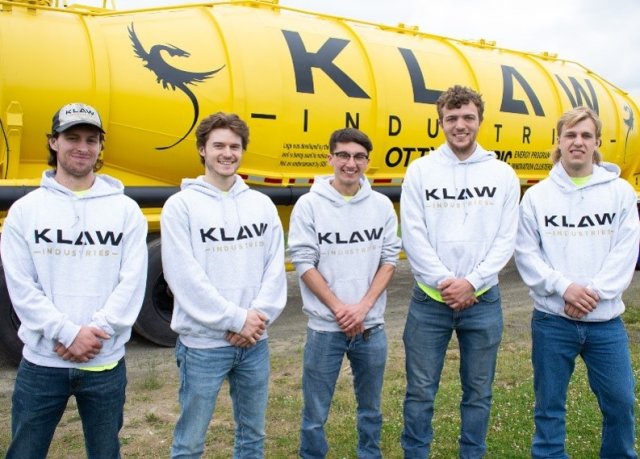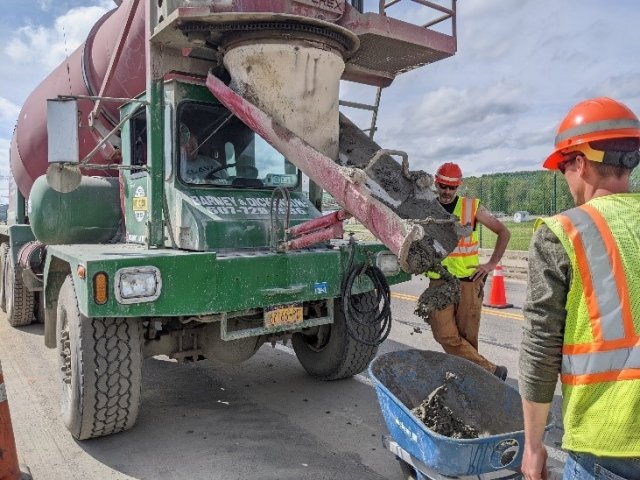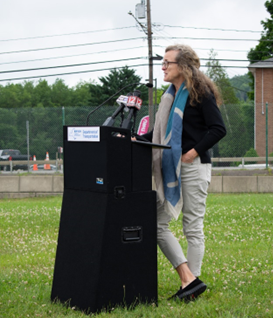Recycled Glass: EPA-Funded Technology Provides a Renewable Alternative to Concrete in New York
Published September 3, 2024

Circular economies can reduce material use, redesign materials to be less resource intensive, and recapture “waste” as a resource to manufacture new materials and products. A circular economy keeps materials and products in circulation for as long possible. Circularity is an important part of sustainability as it seeks to reduce the negative life cycle impacts of materials, including climate impacts and reducing the use of harmful materials. The concept of circularity is embraced within the sustainable materials management approach that EPA and other federal agencies have been pursuing since 2009.
Glass is a significant material processed by the recycling industry, with an estimated 12 million tons created annually in the U.S.; however, only around 3 million tons are recycled, resulting in a recycling rate of 25%. While this is a sizeable start, approximately 9 million tons of waste glass still end up in landfills each year that could be used for something more sustainable through reuse.

One company making great strides in this field is KLAW Industries (KLAW), a New York-based business that received an EPA Small Business Innovation Research award. KLAW developed an innovative technology that uses recycled glass to create concrete. KLAW was founded in 2019 by Binghamton University sophomore engineering students Jacob Kumpon and Jack Lamuraglia. The pair knew they wanted to work in the recycling industry to make a positive impact but were not sure where to start.
Recognizing the abundance of glass in recycling streams as well as the intense carbon emissions of the cement industry, the founders filed a provisional patent and began developing their technology that incorporates recycled glass particles into concrete. This technology not only creates a high-strength and cost-effective replacement for cement but also reduces carbon emissions during production. To more establish their presence in the concrete industry, KLAW partnered with local Binghamton concrete producers, Barney & Dickenson.

After hearing about EPA’s Small Business Innovation Research (SBIR) program, KLAW applied for and received a Phase I award ($100,000) for “proof-of-concept.” Their project, titled “Prototyping a Process to Reuse Wasted Glass in High Performance Low Carbon Concrete,” served as the company’s first pilot for their new product, which they worked closely on with Barney & Dickenson. This allowed KLAW to use lab testing and demonstrations that helped the technology gain traction in the industry.
After a promising Phase I, the company successfully competed for and received a Phase II award for their project. The Phase II project further tested their cement alterative and focused on promoting their product. This not only increased their experience but also advanced their renown in the local concrete industry. The city of Binghamton released a press release highlighting KLAW and their EPA SBIR award, bringing their project to the attention of the local Binghamton officials. This eventually led to the adoption of KLAW’s glass cement alternative, called Pantheon™, in muncipal projects within the city.
KLAW’s Pantheon™ is a partial cement replacement, which is created from post-consumer glass. Using their patented process, KLAW removes unwanted materials from waste glass, creating a high-quality replacement for traditional cement in concrete. This process strengthens the concrete by reacting with cement to add additional crystal structures in the concrete. By allowing concrete producers to use less cement, Pantheon™ helps lower carbon emissions without incurring additional cost.
After multiple successful local projects and positive feedback about Pantheon™ from concrete producers, KLAW was approached by the New York State Department of Transportation (NYSDOT) for a new project in the Village of Whitney Point.
This project involves using Pantheon™ in the construction of sidewalks, curbs, and barriers in the new U.S. Route 11 bridge as well as 1.5 miles of new sidewalks on US Route 11. It will be KLAW’s largest single location project and their first state-sponsored project. By diverting 106 tons of glass from local landfills and preventing over 72 tons of carbon dioxide emissions, this pilot program in New York showcases the potential for future use of glass-based concrete. The project comes at the right time as New York State begins enforcement of the Buy Clean Concrete Guidelines, which was announced in September 2023.
On June 11, 2024, KLAW Industries joined NYSDOT for a press conference announcing the project.

“This innovative technology not only lowers the cement content used which in turn lowers carbon emissions, but it also strengthens the concrete to ensure infrastructure sustainability all while supporting New York State’s ambitious climate goals,” NYSDOT Chief Engineer Stephanie Winkelhake said.
KLAW’s Chief Operations Officer Jacob Kumpon also expressed that this project will be a turning point for their business.
“[This project] marks our company’s transition out of the startup phase, and we’re excited for this next chapter,” Kumpon said.
EPA SBIR Program Manager April Richards also spoke at the press conference highlighting the technology’s potential in decarbonizing the concrete industry and emphasizing the importance of collaboration between federal, state and local governments to achieve practical solutions.
KLAW’s innovative use of recycled glass in concrete, supported through EPA’s SBIR Program, is just one example of how small businesses can help move us towards a circular economy. These ideas align with the EPA’s goals to address the impacts of materials on our communities and achieve a transformative vision for our waste management system.
Learn More About the Science
